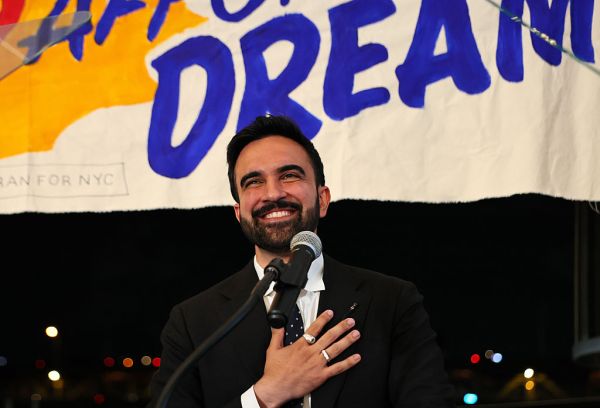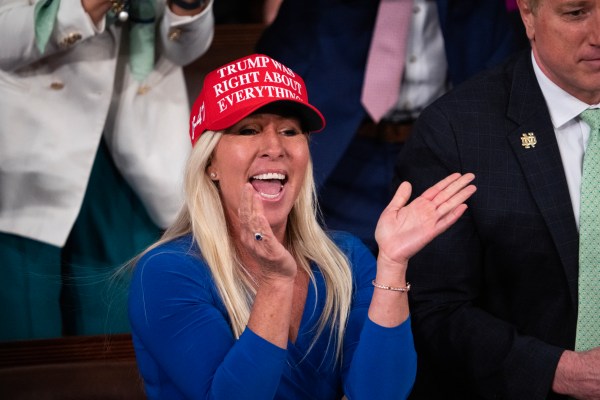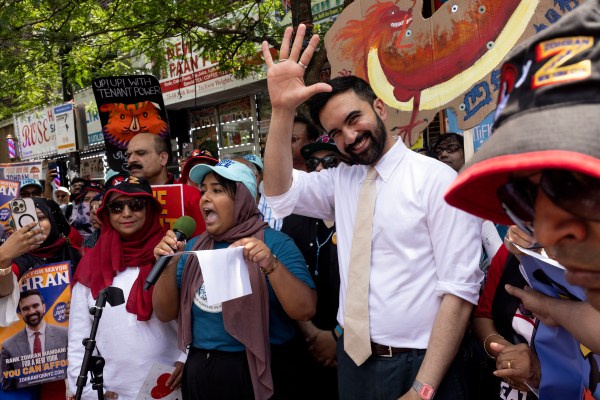CLEVELAND, Ohio—It’s August, when campaigns often slip into a summer lull after hard-fought primaries. But there’s been no break for U.S. Rep. Tim Ryan. He’s flown back to the Buckeye State every chance he gets as he campaigns against Hillbilly Elegy author J.D. Vance for Ohio’s open Senate seat. He’s toured steel and auto manufacturing plants, sipped locally sourced craft spirits at a Toledo distillery, and over the weekend, power-walked his way through a 5K to raise awareness for black men’s health care, introducing himself to attendees along the route.
So far, it’s paying off: Over the summer Ryan’s campaign released an internal poll showing him 3 points ahead of Vance in the bid to fill retiring Republican Sen. Rob Portman’s seat.
“You know, we’re running a strong campaign,” Ryan told The Dispatch. “And they’re scared s—less.”
Recent polling does show Vance in first. A new Emerson College poll finds him ahead by 3 percentage points. And a poll by the Trafalgar Group on Monday shows Vance leading 49.5 percent to Ryan’s 44.9 percent.
But the closeness of the race—Sabato’s Crystal Ball just shifted it Wednesday from Likely Republican to Lean Republican—is a little surprising given Ohio’s recent political trends: Donald Trump won the state by 8 percentage points in both 2016 and 2020. Currently, it has 12 Republican members of the House and only four Democrats, Ryan among them. Republicans control the governor’s mansion and the statehouse.
And alarm bells are going off in GOP circles, in part because of Ryan’s visibility but also his ad spending, coupled with Vance’s less-than-stellar fundraising.
Since the primary, Ryan has dropped more than $8 million on ads. And he’s hauled in cash, too, largely from small dollar donations. In July, he closed out the second quarter with more than $9 million on hand. Ryan is using those ads to portray himself as a moderate Democrat—his website says he’s a “post-partisan populist”—and he’s not been shy trying to woo over the Fox News crowd.
Meanwhile, Vance mostly went dark following a brutal, expensive primary in May that hinged mostly on candidates’ loyalty to former President Donald Trump. An 11th-hour weigh-in by Trump helped Vance secure the plurality of votes in a crowded field.
Vance’s campaign ended the last quarter in the red, owing $883,000 more than it had on hand, according to a Federal Election Commission report. Part of that is because Vance loaned his campaign $700,000 during the primary.
Ryan hopes to keep the race close by painting Vance as the extreme candidate. To that end, he’s highlighted the Supreme Court’s move in June to overturn Roe v. Wade, the landmark decision establishing a federal right to abortion.
“It’s been absolutely energizing,” Ryan told The Dispatch about the Dobbs v. Jackson Women’s Health decision that overturned Roe. He said more Republican women have attended town halls and other campaign events and voiced concerns over abortion policy as the reason.
At a labor rally in Toledo, Ryan said that Republicans, “want to be in everybody’s bedrooms, in everybody’s doctor’s office. … I mean, what planet are we f—ing living on here?”
He referenced the tragic case of a 10-year-old Columbus girl who became pregnant due to rape and then traveled out of state for an abortion. “You’re going to tell a 10 year old girl … that you have no choice? That the government—[Sen. Ted Cruz of Texas], [Rep. Madison Cawthorn], J.D. Vance—that these guys are going to tell you what to do? No! That is the most un-American thing I have ever heard of in my entire life.”*
Ohio’s “heartbeat bill,” passed in 2019 and signed by Gov. Mike DeWine, took effect in June after the Dobbs decision]. It bans abortion after a heartbeat is detectable during a pregnancy. There are exceptions for when the mother’s life is in danger but not for rape.
Republicans told The Dispatch they doubt abortion is a winning issue in the state.
Aaron Baer, president of the Center for Christian Virtue, a Christian nonprofit based in Columbus, told The Dispatch he doesn’t think Dobbs will polarize a new group of voters. He believes most figured out their stance during the state’s legislature’s efforts to pass the heartbeat law. That effort, he recalled, got the front page news treatment for over a decade before DeWine signed it into law.
“The people upset about Roe being overturned—they’re fired up every election, and they turn out every election, and there are just very few of them,” he said.
Ryan, meanwhile, has sought to contrast himself with Vance as a political moderate. At town halls and in interviews he is careful to highlight a number of ways he broke with his party in the past: voting against Nancy Pelosi to be Speaker of the House, opposing the U.S. rejoining the Trans-Pacific Partnership, and voting in support of Trump’s U.S.-Mexico-Canada Agreement. He’s also distanced himself from the president both rhetorically and physically: When Biden came to the state in July, Ryan was nowhere to be seen.
“What they really need to do to be able to win this race is bring back working class Democrats to the Democratic ticket,” Paul Beck, professor emeritus of political science at Ohio State, told The Dispatch. “And so he’s trying to reclaim those voters and you can see that in his campaign.”
At the labor rally, Tony Totty, president of United Auto Workers (UAW) Local 14, told The Dispatch that, “What we like is that he agrees with Trump on trade. We need to bring our products back from China. And that’s his position and we support him because of that.”
But scrutiny of Ryan’s more recent voting record shows less of a moderate and more of a stalwart member of the party faithful: According to FiveThirtyEight, he votes with Joe Biden 100 percent of the time, most recently supporting the $750 billion Inflation Reduction Act. Ryan also voiced support for abolishing the legislative filibuster.
While Ryan has run a politically smart race so far, the closeness of the race is also due to how Vance is running his campaign.
Republican supporters have been scratching their heads because of Vance popping up at a number of events outside the state, ranging from Texas to Tel Aviv, Israel.
Bill Cunningham, a conservative radio host in the state, told The Daily Beast in July that “the Republican party faithful are telling me they can’t find J.D. Vance with a search warrant.”
But national Republicans are coming to Vance’s rescue: Last week, a PAC aligned with Senate Majority Leader Mitch McConnell, the Senate Leadership Fund, announced it will dump $28 million into the race. And soon there will be a response on the airways: The PAC will run ads from Labor Day until Election Day. Republicans in state said they expect billionaire Peter Thiel, who financed Vance during the primary, will write another check later in the race if needed.
And Vance may be getting the message about needing to be more visible: Last Friday, he rallied alongside Florida Gov. Ron DeSantis in a packed hotel ballroom in Girard, Ohio. It was the most high-profile appearance Vance has made since the primary.
In his speech, Vance focused on a host of red-meat issues. He took aim at Ryan and President Joe Biden for illegal immigration and drug trafficking at the U.S.-Mexico Border, for jobs moving overseas and depleting the strength of America’s manufacturing sector, and at vaccine mandates during the COVID-19 pandemic.
“Joe Biden and Tim Ryan said that in order to work, in order to make a living, in order to put bread on the dinner table of your children, you had to get Big Pharma’s vaccine.” He said, drawing boos from the crowd. “Now, ladies and gentleman, that was disgusting.”
Vance said voters are facing a choice of whether Ohio will “continue to be a state that provides opportunities for patriotic Americans or will we continue to go down the path of Joe Biden and Tim Ryan of failure, of loss of opportunity and loss of what makes this country great.”
Vance’s campaign did not respond to The Dispatch’s requests for an interview.
He may not be projecting as much strength as Republicans would have hoped, but political watchers in the state still said that they are confident he will finish strong. “I think the general is going to be really straightforward,” Baer said.
But Democrats in the state aren’t counting Ryan out.
Blaine Griffin, president of the Cleveland City Council, told The Dispatch at the 5K rally that voters “really believe he has a shot. For the first time in a long time people see Tim Ryan as an opportunity to lift the entire ticket.”
“I’m originally from Youngstown—so he’s a hometown guy. And I like his style … he’s a kind of guy that is going to go and fight for Midwest values,” Griffin said. “We want somebody who is not too far left and not too far right.”
*Correction, August 26: This piece incorrectly identified Ted Cruz as being from Florida and described Madison Cawthorn as a former representative.






Please note that we at The Dispatch hold ourselves, our work, and our commenters to a higher standard than other places on the internet. We welcome comments that foster genuine debate or discussion—including comments critical of us or our work—but responses that include ad hominem attacks on fellow Dispatch members or are intended to stoke fear and anger may be moderated.
With your membership, you only have the ability to comment on The Morning Dispatch articles. Consider upgrading to join the conversation everywhere.